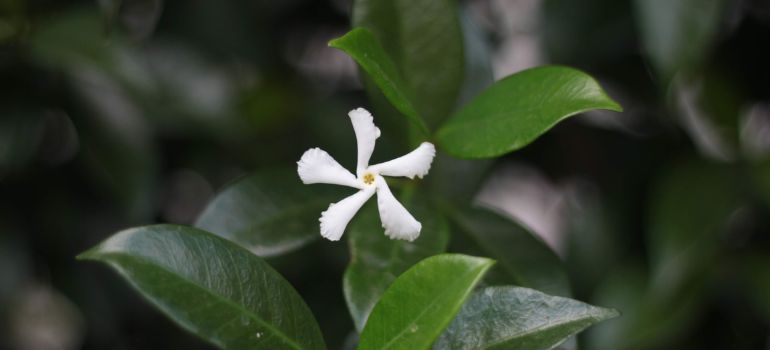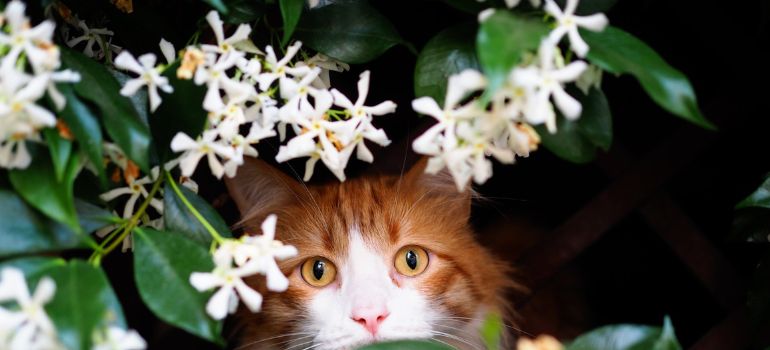Jasmines are renowned for their enchanting fragrances, and two varieties that often steal the spotlight are Pink Jasmine and Star Jasmine. As you embark on a fragrant journey for your garden, understanding the nuances of these aromatic wonders becomes essential.
Origins and Botanical Characteristics
Pink Jasmine, scientifically known as Jasminum polyanthum, originates from China and Southeast Asia. Its delicate pink blossoms and vigorous vines make it a popular choice for gardeners seeking a touch of elegance. On the other hand, Star Jasmine, scientifically named Trachelospermum asiaticum, hails from Japan and Korea. Known for its glossy foliage and star-shaped white flowers, this jasmine variety adds a classic charm to any landscape.
Appearance and Growth Patterns
The visual appeal of Pink Jasmine lies in its profusion of pink flowers, creating a breathtaking display. This jasmine variety is a fast climber, adorning trellises and archways with its cascading vines. In contrast, Star Jasmine boasts glossy, dark green leaves and compact growth. Its vines sprawl horizontally, forming a dense and lush carpet of greenery.
Fragrance Profile
Pink Jasmine captivates with its sweet and intense fragrance, filling the air with a heady aroma. The scent is often described as a blend of sweetness and floral notes, creating a sensory delight. Star Jasmine, with its sweet and exotic fragrance, offers a different olfactory experience. The fragrance is subtle yet alluring, making it a favorite for those who prefer a more understated aroma.
Climatic Preferences
Pink Jasmine thrives in mild to warm climates, with temperatures between 15°C to 25°C (59°F to 77°F). It prefers partial shade but can tolerate full sun. On the other hand, Star Jasmine is known for its adaptability, growing well in both warm and cool climates. It can handle full sun to partial shade, making it a versatile choice for various regions.
Cultivation and Maintenance
When cultivating Pink Jasmine, ensure well-draining soil and provide support for its climbing nature. Regular pruning helps maintain its shape and encourages abundant blooms. Star Jasmine, on the other hand, is relatively low-maintenance. Plant it in well-drained soil, and occasional pruning helps control its size and shape.
Landscaping Applications

Landscaping with jasmine varieties can add a touch of elegance and fragrance to your outdoor space. Whether you prefer the romantic allure of Pink Jasmine or the classic charm of Star Jasmine, both varieties offer unique landscaping opportunities. Here are some creative ways to incorporate these aromatic wonders into your garden:
- Trellis Marvel:
- Use Pink Jasmine to create a stunning trellis display. The climbing nature of this jasmine variety makes it perfect for covering trellises, arches, or pergolas. Imagine a fragrant gateway to your garden adorned with cascading pink blooms.
- Ground Cover Delight:
- Star Jasmine’s low, spreading growth habit makes it an excellent ground cover. Plant it along pathways or as a border for a fragrant carpet of greenery. Its glossy foliage and star-shaped flowers will add visual interest to the ground level.
- Container Charm:
- Both Pink Jasmine and Star Jasmine thrive in containers. Place potted jasmines on patios, balconies, or near entrances to enjoy their fragrance up close. Choose decorative containers to enhance the overall aesthetics.
- Garden Borders:
- Create defined garden borders with the neat and compact growth of Star Jasmine. Its versatility allows it to act as a natural edging, framing flower beds or pathways with a touch of sophistication.
- Climbing Walls:
- Allow Pink Jasmine to climb and cover plain walls, transforming them into fragrant vertical gardens. This not only adds visual interest but also maximizes space in smaller gardens.
- Mixed Plantings:
- Integrate Pink Jasmine into mixed plantings to create a multi-layered and diverse garden. Its climbing vines can intertwine with other plants, adding a dynamic and visually appealing aspect.
- Fragrant Borders:
- Use Star Jasmine as a fragrant border for outdoor seating areas. The subtle aroma will enhance the ambiance, creating a serene and relaxing atmosphere.
- Topiary Accents:
- Experiment with topiary designs using Pink Jasmine. With careful pruning, you can shape it into unique forms, adding a touch of artistry to your garden.
- Balcony Bliss:
- For urban dwellers with limited space, consider placing containers of Pink Jasmine or Star Jasmine on balconies. The fragrance will waft through the air, providing a refreshing oasis in the midst of the city.
- Arboreal Ambiance:
- Plant Pink Jasmine at the base of trees, allowing it to climb and intertwine with the tree branches. This creates a whimsical and enchanted atmosphere, especially when the jasmine blooms.
Remember to consider the specific growth patterns, sunlight requirements, and maintenance needs of each jasmine variety when incorporating them into your landscaping. Whether you opt for the dramatic Pink Jasmine or the understated beauty of Star Jasmine, these fragrant additions will undoubtedly elevate the charm of your outdoor haven.
Pest and Disease Resistance
Pink Jasmine exhibits good resistance to pests and diseases, making it a hardy choice for gardens. Star Jasmine is also resilient, with its thick foliage acting as a deterrent to many pests. Proper care and monitoring ensure both varieties remain healthy and vibrant.
Seasonal Blooms
Pink Jasmine graces gardens with its fragrant blossoms in late winter to early spring. It’s a welcome sight during the cooler months. In contrast, Star Jasmine tends to bloom from late spring to early summer, filling the warmer days with its delightful fragrance.
Versatility in Gardens
Whether you have a formal garden or a more relaxed landscape, Pink Jasmine adapts seamlessly. Its climbing nature adds vertical interest, and it works well with other flowering plants. Star Jasmine, with its neat and compact growth, suits modern or traditional gardens and can be used to create borders or define spaces.
Pruning Techniques
Proper pruning is essential for maintaining the health, shape, and blooming potential of both Pink Jasmine and Star Jasmine. Here are specific pruning techniques for each variety to ensure optimal growth and a vibrant display of fragrant flowers:
Pink Jasmine Pruning Techniques
- Post-Bloom Pruning:
- Prune Pink Jasmine after its main blooming period, typically in late spring or early summer. This encourages the plant to put energy into new growth and ensures a profusion of blossoms in the next flowering season.
- Shape Maintenance:
- Trim back any unruly or excessively long branches to maintain the desired shape of your Pink Jasmine. This is crucial, especially if it’s growing on a trellis or other support structure.
- Deadheading:
- Remove spent flowers regularly to promote continuous blooming. Deadheading prevents the plant from directing energy into seed production and encourages the development of new buds.
- Thinning Out:
- Periodically thin out the interior of the plant to improve air circulation and sunlight penetration. This reduces the risk of diseases and ensures that all parts of the plant receive adequate light.
- Cutting Back Overgrowth:
- If Pink Jasmine becomes too dense or overgrown, cut back some of the older stems to rejuvenate the plant. This encourages new growth from the base and maintains a healthy and vigorous specimen.
Star Jasmine Pruning Techniques
- Regular Light Pruning:
- Unlike Pink Jasmine, Star Jasmine benefits from light pruning throughout the year. This helps control its size and shape, preventing it from becoming overly leggy or sprawling.
- Post-Flowering Pruning:
- Prune Star Jasmine after its main flowering period, typically in late spring or early summer. This allows you to shape the plant and remove any dead or spent flowers, promoting a tidy and well-maintained appearance.
- Trimming for Bushier Growth:
- To encourage a bushier habit, trim the tips of the branches regularly. This stimulates the growth of lateral shoots, creating a denser and more compact foliage arrangement.
- Controlling Size:
- If Star Jasmine starts to outgrow its allotted space, prune it back to the desired size. This is especially important for ground cover applications or when using Star Jasmine in containers.
- Removing Diseased or Damaged Branches:
- Inspect Star Jasmine regularly for diseased or damaged branches and promptly remove them. This prevents the spread of diseases and encourages the overall health of the plant.
Remember to use sharp, clean pruning tools to make precise cuts, reducing the risk of damage or infection. When pruning either Pink Jasmine or Star Jasmine, consider the natural form of the plant and aim to enhance its beauty while maintaining a healthy structure. These pruning practices will ensure that your jasmines thrive and continue to grace your garden with their delightful fragrances.
Environmental Impact
Both Pink Jasmine and Star Jasmine play a vital role in attracting pollinators like bees and butterflies. Their fragrant flowers contribute to the overall biodiversity of the garden, creating a harmonious and sustainable ecosystem.
Popular Varieties
Popular cultivars of Pink Jasmine include ‘Belle of India’ and ‘White Lightning,’ each offering slight variations in flower color and growth habits. Star Jasmine enthusiasts often seek out ‘Asian Garden’ and ‘Variegatum’ for unique foliage patterns and robust growth.
Pros and Cons
Pink Jasmine’s pros include its rapid growth and abundant blooms, but it may become invasive if not properly managed. Star Jasmine’s advantages lie in its adaptability and low-maintenance nature, but it might be less vigorous in colder climates.
Conclusion
In the battle of Pink Jasmine vs Star Jasmine, the choice ultimately depends on your preferences and garden requirements. Whether you seek the dramatic, cascading blooms of Pink Jasmine or the neat, compact beauty of Star Jasmine, both varieties bring unique charm to your outdoor space. Consider the climate, maintenance level, and visual appeal to make an informed decision.
FAQs
Star Jasmine, with its compact growth, is ideal for smaller gardens or container planting.
While Pink Jasmine prefers partial shade, Star Jasmine can tolerate both full sun and partial shade.
Prune Pink Jasmine after the flowering season to maintain its shape and encourage more blooms.
Star Jasmine is more adaptable to colder climates compared to Pink Jasmine.
Yes, both Pink Jasmine and Star Jasmine attract pollinators, including bees and butterflies.



